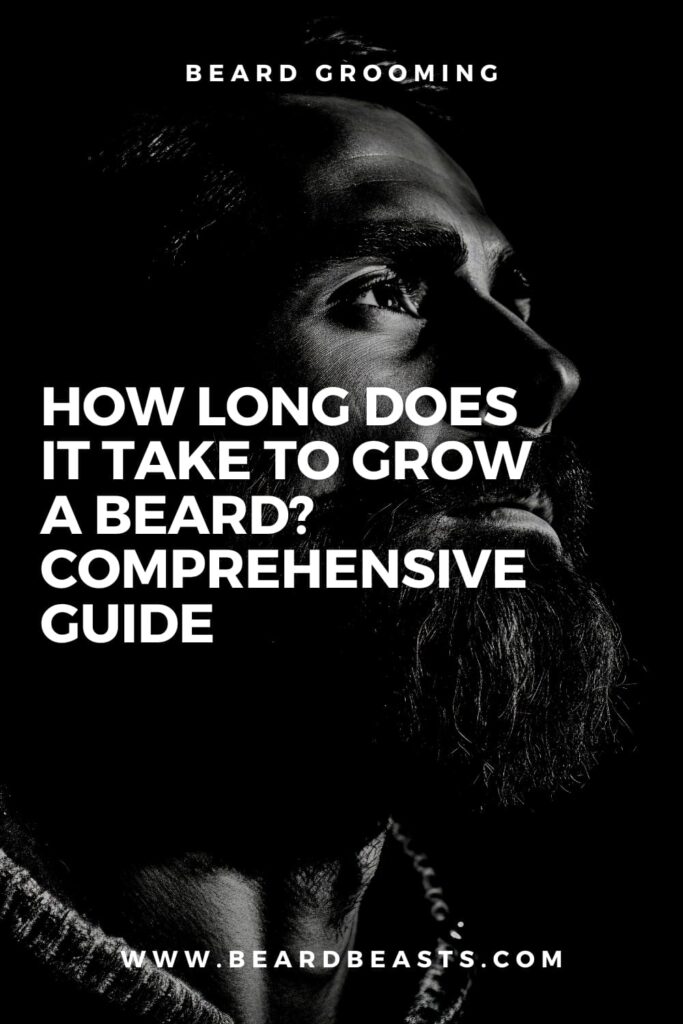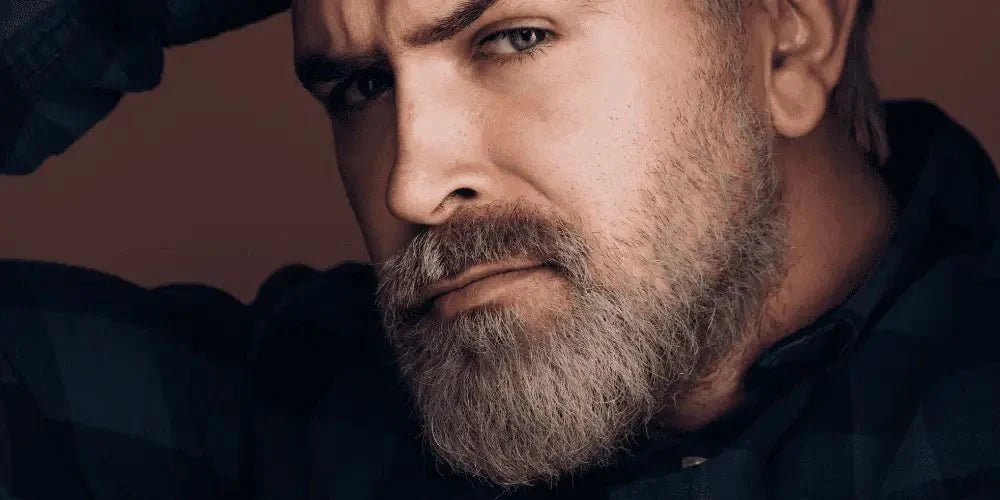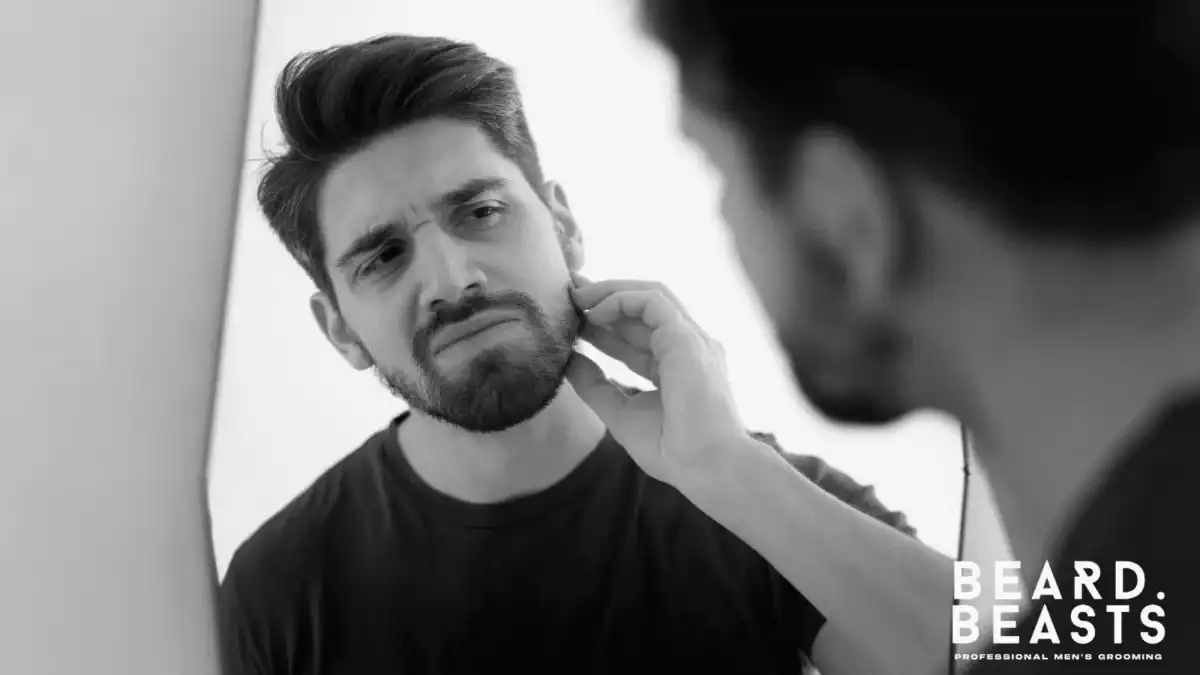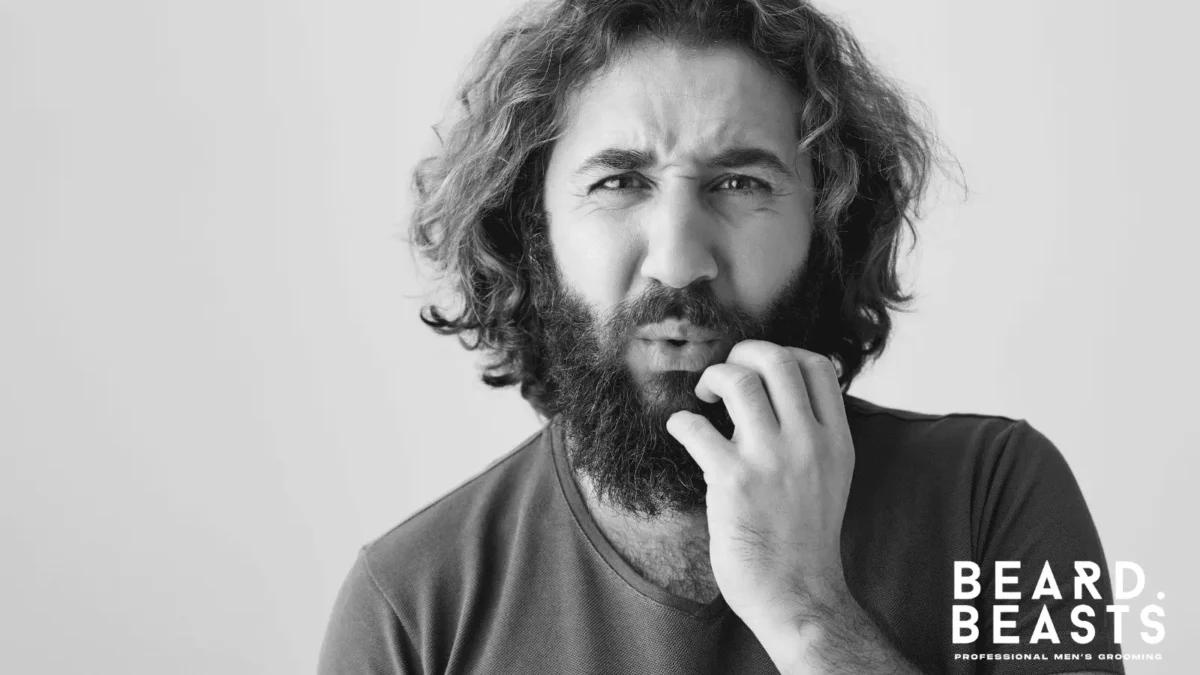Have you ever wondered, ‘How long does it take to grow a beard?’ You’re not alone! Growing a beard is a journey unique to each individual, blending genetics, care routines, and a bit of patience. It’s not just about waiting for hair to sprout on your face. It’s about understanding how your body works to nurture a beard from its initial fuzz to a full, majestic form.
Beard growth is a natural process, but it’s often shrouded in mystery. Some men find themselves with a thick beard in just a few weeks, while others may wait months to see substantial growth. This variety is perfectly normal. What’s important is knowing that beard growth is not a one-size-fits-all process. It’s a personal experience that can be influenced by factors like genetics, age, and health.
Importance of Patience in Growing a Beard
When embarking on your beard-growing journey, patience is more than a virtue—it’s a necessity. Growing a beard is a commitment, a long-term endeavor that requires dedication. It’s easy to get impatient, especially when you’re constantly checking for progress. But remember, great things take time.
During the early stages, you might encounter itchiness or patchiness. This is where patience truly plays a role. It’s crucial to resist the urge to shave it all off. Instead, focus on proper beard care, nutrition, and perhaps even gentle grooming techniques to encourage growth.
Patience in beard growth isn’t just about waiting; it’s about understanding and embracing the process. Every day, your beard is a little bit closer to reaching its full potential. By appreciating each stage of growth, you’ll find joy in the journey, not just the destination.
As you continue to read this ‘How long does it take to grow a beard?’ article, remember that growing a beard is an adventure. It’s a way to express yourself and connect with a timeless tradition of masculinity. So, let’s dive deeper into the world of beard growth, understanding the factors that influence it, and discovering tips to help you grow the beard of your dreams. Stay patient, stay committed, and watch as your facial hair transforms into a symbol of your perseverance and style.
Understanding Beard Growth
When delving into the science of beard growth, it’s fascinating to see how each strand of hair on our face is a product of complex biological processes. It all starts beneath the skin in the hair follicles. These tiny structures are where the magic happens – they’re the birthplace of every beard hair.
Beard growth occurs in three primary stages: the anagen phase, catagen phase, and telogen phase. The anagen phase is when the hair actively grows, and this can last from a few months to several years. The length of this phase largely determines how long your beard can grow. After this, the catagen phase is a short transitional period when the hair stops growing and the follicle shrinks. Finally, the telogen phase is a resting period. At the end of this stage, the hair falls out, and the cycle begins anew.
Testosterone, a key hormone in males, plays a vital role in this process. It not only stimulates hair growth but also affects the thickness and strength of each hair. This is why beard growth often accelerates during puberty when testosterone levels are on the rise.
Factors Influencing Beard Growth Rate
Understanding how long does it take to grow a beard requires looking at the factors influencing beard growth rate. There’s no universal answer, as several elements come into play:
Genetics: Just like the color of your eyes or your height, your genes play a crucial role in determining your beard’s characteristics. Some men are genetically predisposed to grow thick, full beards, while others may find their beards are sparser or grow more slowly.
Age: Generally, as men get older, their beards tend to grow more fully. This is because their bodies have had more time to produce testosterone. However, the growth rate and thickness can vary widely among individuals.
Health and Nutrition: A healthy diet rich in vitamins and minerals can promote stronger and faster beard growth. Proteins, biotin, and omega-3 fatty acids are particularly beneficial for hair health.
Lifestyle Choices: Factors like stress, sleep quality, and exercise can impact your body’s overall health, including your beard’s growth rate. A healthier lifestyle can lead to better beard growth.
Hormonal Balance: Hormones, especially testosterone and dihydrotestosterone (DHT), significantly influence beard growth. An imbalance can affect how your beard grows.
Skincare Routine: Proper skin care can also affect beard growth. Keeping your face clean and well-moisturized creates a healthy environment for hair to grow.
Remember, each person’s beard journey is unique. While you might not have control over all these factors, understanding them can help you set realistic expectations and find ways to encourage your beard’s growth. Patience and care are your best tools in growing a beard that you can be proud of.
The Beard Growth Timeline
The first phase in the beard growth journey is often the most challenging and exciting. You might find yourself asking, How long does it take to grow a beard, and when will I see the first signs? The answer begins in these initial weeks.
During the early stages, typically the first month, your beard is just getting started. It might appear uneven, patchy, or sparse. This is completely normal. In these weeks, your hair follicles are waking up and starting to grow hair at their own pace. Some areas of your face might sprout hair faster than others, leading to an uneven look.
It’s crucial during this phase not to get discouraged. Resist the temptation to trim or shape your beard too soon. Let it grow naturally, and give those slower-growing areas time to catch up. This is also the time when you might experience itchiness, a common part of the process as the skin adjusts to growing hair. Keep your skin hydrated with a nourishing beard oil to alleviate discomfort.
Mid-Stage: Noticeable Beard Development
As you move into the second and third months, your patience starts paying off. This is when most men notice significant changes in their beard’s appearance. It’s getting fuller, thicker, and takes on a more defined shape.
This mid-stage of beard growth is crucial for understanding how your beard behaves and its natural growth pattern. You’ll get a clearer picture of the density and coverage your beard can achieve. It’s also the time to start a basic beard care routine. Light trimming and shaping can be done to maintain a neat appearance, but be cautious not to overdo it. Use a good beard comb or brush to train your beard hairs to grow in the desired direction.
Full Beard Achievement: What to Expect
Reaching the full beard stage is a milestone in your beard-growing journey. This usually happens around the 4th to 6th month, depending on your individual growth rate. By now, you have a well-established beard, and the question ‘How long does it take to grow a beard?’ has been answered by your own experience.
In this phase, your beard has reached its most vigorous growth stage. It’s thicker, fuller, and requires regular grooming to keep it looking its best. Now is the time to invest in quality grooming tools and products. Establish a routine that includes washing, conditioning, and applying beard oil or balm to maintain the health of your hair and skin.
Expect to trim and shape your beard more regularly to maintain your preferred style. This is also when you can experiment with different beard styles to see what suits you best.
Throughout the beard growth timeline, remember that every man’s beard is unique. Your beard might grow faster or slower than others, and that’s perfectly fine. The key is to enjoy the journey, care for your beard, and wear it with pride. With patience and care, you can achieve a beard that’s not only a statement of personal style but also a testament to your dedication.
Influential Factors
When pondering the question, “How long does it take to grow a beard?” it’s essential to consider the role of genetics. Just like the color of your eyes or your height, your genes play a significant role in determining your beard’s characteristics. Genetics influence not only the speed at which your beard grows but also its thickness, texture, and color.
Your genetic blueprint is inherited from your parents and dictates how your beard will develop. Some men have genes that promote dense, quick beard growth, while others might have genes that result in a lighter or patchier beard. It’s important to remember that there’s no “right” or “wrong” when it comes to your beard’s genetic makeup. Embrace your unique beard, understanding that it’s a part of your individuality.
The Impact of Lifestyle on Beard Growth
Lifestyle choices play a crucial role in the health and growth of your beard. A balanced diet, regular exercise, and adequate sleep all contribute to optimal beard growth. Foods rich in proteins, vitamins, and minerals can provide the necessary nutrients for healthy hair growth. Regular exercise improves blood circulation, which helps to nourish the hair follicles.
Stress is another factor that can significantly impact your beard growth. High stress levels can lead to hair loss and slow down the growth process. Finding effective ways to manage stress, like meditation, yoga, or other relaxation techniques, can be beneficial for your overall well-being and, consequently, your beard growth.
Smoking and excessive alcohol consumption can also negatively affect your beard. These habits can lead to poorer health and, in turn, affect the quality of your hair growth. Reducing or eliminating these habits can improve not only your beard growth but also your overall health.
Age and Hormonal Effects on Beard Growth
Age and hormones, particularly testosterone, are closely linked to beard growth. Most men experience increased beard growth in their late teens and early twenties, which coincides with peak testosterone levels. As men age, their hormone levels fluctuate, which can impact the density and growth rate of their beard.
Testosterone and its byproduct, dihydrotestosterone (DHT), play crucial roles in developing facial hair. These hormones are responsible for the initial onset of beard growth during puberty and continue to influence its characteristics throughout a man’s life. However, it’s worth noting that more testosterone doesn’t always mean a thicker beard. The sensitivity of your hair follicles to these hormones also plays a vital role.
Understanding that age and hormonal levels can affect beard growth helps set realistic expectations. It’s normal for beard growth to change as you age, and these changes are a natural part of life.
In conclusion, various factors influence how long it takes to grow a beard and its overall appearance. While some of these factors are within your control, others, like genetics and hormonal makeup, are part of your unique identity. Embracing these factors and understanding their impact can help you enjoy your beard-growing journey and appreciate the unique beard you grow.
Accelerating Beard Growth
For many aspiring beard growers, the question, How long does it take to grow a beard? often leads to exploring products that can help accelerate beard growth. The market is filled with a variety of beard growth products, each promising to enhance your beard’s appearance and growth rate. Here are some of the most effective types:
Beard Oils and Balms: These products are essential for keeping both your beard and the skin beneath it hydrated and nourished. Ingredients like jojoba oil, argan oil, and vitamin E can help in maintaining a healthy beard, possibly aiding in faster growth.
Beard Growth Serums and Sprays: These specialized products often contain active ingredients that can stimulate hair follicles, potentially speeding up beard growth.
Supplements for Beard Growth: Biotin, a B-vitamin, is widely recommended for hair growth. Other supplements include vitamins A, C, D, E, and minerals like zinc and iron, which are essential for healthy hair growth.
When choosing products, it’s important to consider your skin type and any sensitivities or allergies. Always opt for high-quality beard care products from reputable brands to ensure safety and effectiveness.
Natural Remedies and Techniques
In addition to commercial products, natural remedies and techniques can be employed to potentially boost beard growth:
Essential Oils: Oils such as castor oil, peppermint oil, and eucalyptus oil are known for their hair growth-promoting properties. They can be mixed with a carrier oil and applied to the beard area.
Exfoliation: Regularly exfoliating the skin under your beard can help remove dead skin cells and promote better blood circulation, fostering a healthier environment for hair growth.
Regular Trimming: While it doesn’t directly make your beard grow faster, regular trimming can help keep your beard looking neat and can rid it of split ends, making your beard appear fuller and healthier.
Diet and Exercise for Optimal Beard Growth
What you eat and how you treat your body significantly impacts your beard’s health and growth rate. Incorporating a balanced diet and regular exercise can create the optimal conditions for hair growth:
Protein-Rich Diet: Hair is primarily made of protein, so a diet rich in proteins (like lean meats, fish, eggs, and legumes) can support hair growth.
Vitamins and Minerals: Foods high in vitamins A, B, C, D, E, and minerals like zinc and iron are crucial for hair health. Fruits, vegetables, nuts, and seeds are great sources.
- Hydration: Drinking plenty of water is essential for overall health and can also help in maintaining a healthy beard.
Regular Exercise: Exercise increases blood flow throughout the body, including to your facial hair follicles, potentially aiding in faster hair growth.
In summary, while the rate of beard growth is primarily determined by factors like genetics and age, using the right products, employing natural remedies, and maintaining a healthy lifestyle can contribute to a healthier, fuller beard. Remember, consistency is key, and patience is still the most important aspect of growing a beard.
Common Challenges and Solutions
Growing a beard is a journey filled with ups and downs. As you seek to answer the question, “How long does it take to grow a beard?” you may encounter some common challenges. Here’s how to address them:
Dealing with Patchy Beard Growth
Patchiness is a common concern for many men in the early stages of beard growth. It can be caused by a variety of factors, including genetics and age.
Solutions:
- Give It Time: Often, patchiness resolves itself with time as the beard grows longer and thicker.
- Proper Grooming: Regular grooming and styling can help in camouflaging patchy areas. A well-trimmed beard often looks more even.
- Healthy Lifestyle: A balanced diet and proper skin care can promote healthier hair growth.
- Beard Products: Certain products like beard balm or oil can help in managing and styling patchy beards.
Overcoming Slow Growth Challenges
Some men may find that their beard grows slower than they’d like. This can be due to genetic factors or lifestyle habits.
Solutions:
- Patience is Key: Understanding that each person’s beard growth rate is different is important. Patience goes a long way.
- Healthy Habits: A healthy lifestyle, including a balanced diet and regular exercise, can support natural hair growth.
- Beard Supplements: Supplements containing biotin, vitamins, and minerals can sometimes aid in hair growth.
- Regular Care: Maintaining a regular beard care routine can encourage healthier and potentially faster growth.
Maintaining Beard Health During Growth
As your beard grows, maintaining its health is crucial for a good-looking, comfortable beard.
Solutions:
- Regular Washing and Conditioning: Just like scalp hair, beards need regular cleaning and conditioning. Use products specifically designed for beards to prevent dryness and irritation.
- Beard Oils and Balms: These products help in keeping the beard soft, moisturized, and manageable.
- Trimming and Shaping: Regular trimming helps in getting rid of beard split ends and maintaining the desired shape of your beard.
- Skin Care: The skin beneath your beard needs attention too. Keeping it clean and moisturized prevents itchiness and dandruff.
In conclusion, while challenges like patchiness, slow growth, and maintenance issues are common, there are effective ways to manage them. Patience, proper care, and a healthy lifestyle are crucial in overcoming these hurdles. Remember, every beard is unique, and embracing your individual journey is part of the fun and reward of growing a beard.
FAQs About How long does it take to grow a beard
Growing a beard can be an exciting but sometimes perplexing experience. Many men have questions about this process, especially regarding How long does it take to grow a beard? and other common inquiries. Here are some frequently asked questions and their answers to help guide you on your beard-growing journey.
How Long Does It Take to Grow a Full Beard?
- The time it takes to grow a full beard varies for each individual. On average, it can take about two to six months to grow a full beard, depending on factors like genetics, age, and health. Patience is key!
Why Is My Beard Growing Patchy?
- Patchiness in beard growth is often due to genetic factors, though it can also be influenced by health and age. In many cases, giving your beard more time to grow can help cover patchy areas. Regular grooming and a healthy lifestyle may also improve the appearance of patchiness.
Can I Make My Beard Grow Faster?
- While you can’t change your genetic growth rate, you can promote healthier and potentially quicker growth. Maintaining a balanced diet, exercising regularly, and using proper beard care products are beneficial. Supplements like biotin might also help.
What Are the Best Foods for Beard Growth?
- Foods rich in proteins, vitamins (especially B vitamins), and minerals like zinc and iron are great for beard growth. Include lean meats, eggs, nuts, whole grains, and plenty of fruits and vegetables in your diet.
How Do I Deal With Beard Itchiness?
- Itchy facial hair is common in the early stages of growth. Keeping your beard and the skin beneath it clean and moisturized helps reduce itchiness. Using beard oils or balms can provide relief and promote healthier skin and hair.
How Often Should I Trim My Beard?
- The frequency of trimming depends on your desired beard length and style. For a well-maintained look, trimming every few weeks is advisable. If you’re growing your beard longer, you may trim less frequently.
Does Shaving Increase Beard Growth?
- Contrary to popular belief, shaving does not cause your beard to grow back thicker or faster. Beard thickness and growth rate are determined by genetics and hormonal factors.
How Can I Style a Patchy Beard?
- For a patchy beard, try a shorter beard style, which can make patches less noticeable. Beard products like waxes and balms can also help in styling and holding hair in place to cover gaps.
Remember, growing a beard is a personal and unique experience for every individual. It requires patience, care, and a bit of know-how. Hopefully, these FAQs have provided insights into common beard growth concerns, helping you on your way to achieving the beard you desire.

Concluding How long does it take to grow a beard
Summarizing Key Points on Beard Growth Duration
As we’ve explored throughout this guide, the question How long does it take to grow a beard? does not have a one-size-fits-all answer. Beard growth is a unique process that varies greatly from one person to another. Generally, it can take anywhere from two to six months to grow a full beard, but this timeframe can be influenced by several factors including genetics, age, health, and lifestyle.
Remember, your beard growth journey is influenced by:
- Genetics: Your genes play a crucial role in determining the growth rate, thickness, and pattern of your beard.
- Lifestyle Choices: A healthy diet, regular exercise, and managing stress can positively impact the health and growth of your beard.
- Age and Hormones: Your age and hormonal balance, particularly testosterone levels, significantly affect your beard growth.
Encouragement and Tips for Beard Enthusiasts
If you’re on the path to growing a beard, or contemplating starting, here are some parting words of encouragement and tips:
Patience is Your Best Ally: Beard growth takes time. Be patient with yourself and your beard. Embrace each stage of growth and remember that the journey is as rewarding as the outcome.
Care for Your Beard: Invest in good quality beard care products and establish a regular grooming routine. This not only helps in maintaining the health of your beard but also makes the growth process more enjoyable.
Healthy Lifestyle Matters: Never underestimate the power of a balanced diet, adequate water intake, and regular exercise. These contribute significantly to the overall health of your hair and skin.
Embrace Your Uniqueness: Every beard is unique. Celebrate your beard’s individual characteristics, whether it’s thick, patchy, long, or short. Your beard is a reflection of your personal journey.
Seek Advice When Needed: If you’re facing challenges with beard growth, don’t hesitate to seek advice from experts or join beard enthusiast communities. There’s a wealth of knowledge and experience out there.
In conclusion, growing a beard is a personal and rewarding journey that requires dedication, patience, and proper care. Whether you’re just starting or are well into your beard-growing journey, embrace each moment and wear your beard with pride. Remember, your beard is not just facial hair; it’s a symbol of your dedication and a testament to your unique style. Keep growing and grooming, and enjoy the journey to your ideal beard!





